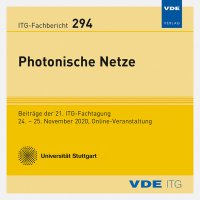Dual-Band Node Architectures for C+L-Band Capacity Upgrades in Optical Metro Transport Networks
Konferenz: Photonische Netze - 21. ITG-Fachtagung
24.11.2020 - 25.11.2020 in online
Tagungsband: Photonische Netze
Seiten: 6Sprache: EnglischTyp: PDF
Autoren:
Emmerich, Robert; Berenguer, Pablo Wilke; Elschner, Robert; Schubert, Colja; Fischer, Johannes Karl; Freund, Ronald (Fraunhofer Institute for Telecommunications, Heinrich-Hertz-Institute, Berlin, Germany)
Eira, Antonio; Costa, Nelson (Infinera Portugal, Carnaxide, Portugal)
Pedro, Joao (Infinera Portugal, Carnaxide, Portugal & Instituto de Telecomunicacoes, Instituto Superior Tecnico, Lisboa, Portugal)
Inhalt:
The upcoming roll out of innovations in the context of 5G and beyond will crunch the capacity of optical metropolitan area networks (MANs). Thus, innovative approaches are required to increase the achievable capacity while still offering competitive solutions that enable reducing the cost-per-bit. Multi-band systems are an interesting solution to address this issue. In this contribution, we investigate the capacity limits of MANs using differentiated node architectures for the C- and the L-band. Two different options to upgrade chain/horseshoe MANs exploring filterless L-band capabilities are experimentally studied. Additional network simulations are carried out to explore the effect of various mesh traffic loads in urban and rural areas. The potential of the filterless L-band for unamplified transmission is first investigated in a back-to-back (btb) experiment under the presence of homodyne in-band crosstalk caused from frequency reuse. Afterwards, an amplified system is used to perform a transmission experiment with up to 80 km of fiber and interfering channels in the C- and L-bands. To better assess the potential of mixing different C+L-band architectures, the experimental results are combined with network simulations, highlighting scenarios where low-cost unamplified L-band extensions can be leveraged to maximize capacity, showing that the node architecture in each band can be practically and cost-effectively geared towards diverse traffic requirements. We show that the total unlocked capacity is larger in scenarios with more meshed traffic, and where the C-band is less able to support that meshed traffic. The ability to reuse frequencies in such scenarios outweighs the need to establish longer lightpaths. Network simulation further demonstrate that such unamplified L-band upgrades can provide a sizeable capacity extension at low costs.


